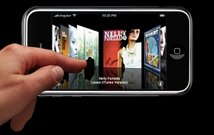Friday, March 27, 2009
Posted by
About Us
at
7:52 PM
0
comments
![]()
Wednesday, December 3, 2008
Apple Has a Virus
Following a flurry of arguably unwarranted media attention, Apple has removed an online help document that advised customers to use multiple antivirus products to keep their computers secure. However, a company spokesman still sees value in antivirus software for the Mac.
"We have removed the KnowledgeBase article because it was old and inaccurate," an Apple spokesman said in an e-mailed statement. "The Mac is designed with built-in technologies that provide protection against malicious software and security threats right out of the box. However, since no system can be 100% immune from every threat, running antivirus software may offer additional protection."
Posted by
About Us
at
10:17 PM
0
comments
![]()
Sunday, October 5, 2008
kick it girl

"Piper Jaffray analyst (and strong Apple bull) Gene Munster told Cult of Mac Tuesday that Apple must report strong sales of Macs during the quarter ending September 27th or "the importance of the new Mac increases substantially." Munster believes that Apple will introduce redesigned notebooks, including a sub-$1,000 MacBook. I've written previously about the importance of a sub-$1,000 MacBook for Apple.
In an investor's note, Munster wrote that Apple is likely to introduce lower-priced products after the company warned of upcoming "new, lower margin products" which haven't yet materialized. "The product changes we have seen thus far do not warrant such a dramatic decrease in margins."
Apple has historically guided expectations lower, but Munster called guidance for 31 percent margins "conservative" and said those numbers were being used to reduce expectations for the latest quarter and for the holidays. Apple warned its quarters would be 31.5 percent in Q3 but that number ended up being significantly higher at 34.8 percent.
Apple's fourth quarter results will be announced after the end of trading Tuesday October 21. Rumors are flying that peg October 14th as the date for new MacBook introductions, but those aren't confirmed yet."
Posted by
About Us
at
1:59 PM
1 comments
![]()
Fring has released the iPhone version of their service today as a free download in the App Store.Fring allows you to chat and interact with others on a variety of networks including Skype, MSN, GoogleTalk, AIM, Yahoo, Twitter, and ICQ. In addition, Fring offers Voice-over-Internet Protocol (VoIP) using the iPhone's Wi-Fi connection. Features listed include:• VoIP (Voice) Calls over WiFi• Instant Messaging• Integrated dynamic contact list with real-time contact availability• SIP integration• Multiple Connection typesFring supports SkypeOut and SIP which allows you to make calls to landline and mobile phones. Some charges may apply depending on the type of call and plan. Fring is available as a free download in the App Store. (App Store Link)Steve Jobs had said that VoIP calls over Wi-Fi was allowable in the App Store when the iPhone SDK was first released. Fring should also work with the new iPod touch, which supports an external microphone.Update: Some are confused about the benefits of fring. One user details some of the features:- Can call directly using iPhone to another person with iPhone running Fring- Call MSN or Skype users that are using their computer- Call using Skype account, which allows you to have your own Skype number and at a discount rate for international calls- Receive phone calls using Skype with your own custom Skype number- Basic chat functions with most chat platforms, such as AIM, Yahoo and ICQ
Posted by
About Us
at
1:58 PM
0
comments
![]()
Wednesday, October 1, 2008
Apple Troubles
"Yesterday, Apple's stock price took a huge hit based on their revised growth estimates, and their weak outlook in a poor US economy. Apple relies on a strong medium to high end consumer market to profit from their notebook and desktop lines. Though this gives them strong control in a niche market, this surely will hurt them at a time when discretionary spending will go down. As the phone market gets more and more saturated iPhone sales will slow hurting Apple's bottom line. Apple is severely lacking an enterprise business and they are not able to sell notebooks to businesses due to their costs and that they are not universally compatible.
People who don't see Apples niche market as a weakness do not understand the tech industry. In the US growth has slowed for these companies and they rely on emerging market growth to pick up the slack. For an emerging market, Apple's products are over-valued and frankly people in emerging markets are not willing to pay so much for a system that they probably don't need. Companies like HP and Lenovo which have low-end machines are dominant in this market; therefore, enabling them to survive through tough economic times. The second problem, relating to Apple's lack of exposure in a commercial environment, deprives them from crucial services revenue during an economic contraction. The few businesses that do use Apple products internally are less likely to upgrade or replace any hardware."
Posted by
About Us
at
6:34 AM
0
comments
![]()
Monday, September 1, 2008
How To Build A Great iPhone App - Forbes.com
The problem is, if applications aren't easy to use, they won't have a future. The phone only has a limited amount of memory. In addition, too many unused applications will only make the phone harder to get around. "Novelty increases people's tolerance for unusable things," says Dave Yeats, a senior research scientist at Perceptive. "As they use it and the novelty wears off, some of these usability problems will start to be more irritating."
Even when an iPhone has the capability to do something, some applications tap that feature better than others--a situation that can vex some users. For instance, some applications are tuned to be exquisitely sensitive to the phone's accelerometer. Tilt the phone just a hair in some applications and a game character, for example, might go flying off the screen. Other applications, such as a free game called "Tilt Snake," aren't sensitive enough. "You had to almost hold your phone upside down and shake it to get the snake to turn," Yeats says.
The iPhone's original applications typically relied on the same cues for navigating through a program. Not so with the hundreds of newbie apps. "Things that were typically on the top would go to the bottom," Thornton says. "Now there is more variation out there."
Shortcuts are another thing Apple does well. For example, when a user pulls up the keyboard to type in a URL on their gadget, it includes a button marked ".com" that saves them four taps. "They just put themselves in the users' shoes to think about what the user is doing at a particular moment," Yeats says.
The solution, according to Thornton, is to study the applications Apple has crafted for the phone and to copy their structure. One of Apple's best tricks, Thornton says, is to use visual cues to help users figure out what to do next. For example, when a phone goes into sleep mode, an animated slider bar draws users' attention to what they have to do to wake the phone up.
"It's a simple thing like letting your user know where they are at all times," says Yeats. "When your screen is so small, you have to let users know where they are at all times."
And if you're lost on how to help your users find their way, just crack open one of Apple's applications and see how it does it.
Posted by
About Us
at
3:39 PM
0
comments
![]()






